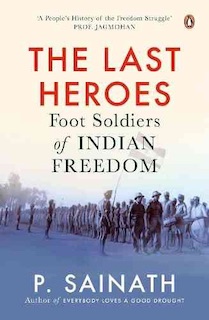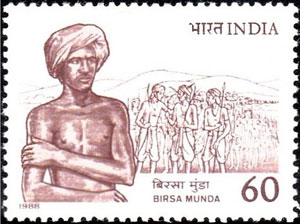Imagine a 25-year-old who took on an empire, left an indelible mark on tribal rights across the country and was seen as a mystic and folk hero for hundreds of thousands. Few would have achieved so much in so short a time and it’s not surprising then that Birsa Munda’s portrait hangs proudly in India’s parliament. | Read the full story here >>
From the Munda tribe that still dominates the Chotanagpur Plateau region in present-day Jharkhand was Birsa. He successfully rallied people across this region to take on the British attempts to grab land in the late 19th century. […]
By holding him in captivity, the British sought to ‘explode the myth of Birsa’s divinity and to kill […]
Source: “Birsa Munda – The Tribal Hero” by Aditi Shah on livehistoryindia.com, July 26, 2018
URL: https://www.livehistoryindia.com/history-daily/2018/07/26/birsa-munda
Date accessed: 3 July 2020
Birsa Munda, the Tribal Folk Hero Who Gave the British Sleepless Nights! | Read the full article by Rinchen Norbu Wangchuk in The Better India >>
“In August 1897 Birsa Munda along with 400 of his men armed with bows and arrows, attacked the Khunti Police Station. In 1898, on the banks of the river Tanaga, the Mundas faced a British force which they initially defeated. Further action of the British, however, resulted in the arrest of many men and women,” says this Indian Post tribute.
However, his struggle was not just against the British, but also the ignorance in his community. He sought to rid the Munda community of superstition, animal sacrifice and alcoholism. […]
The history of tribal communities in India post-Independence is replete with stories of exploitation and denial of access to basic amenities. So yes, Birsa Munda was an exceptional freedom fighter who took on the British. However, he entered this protracted battle so that the Mundas and other Adivasi communities could reclaim ownership of not just their resources but their way of life.
Source: Birsa Munda, the Tribal Folk Hero Who Gave the British Sleepless Nights!
URL: https://www.thebetterindia.com/146164/birsa-munda-tribal-hero-british-freedom-struggle-parliament/
Date visited: 4 September 2019
Birsa Munda (1875–1900) was an Indian tribal freedom fighter, religious leader, and folk hero who belonged to the Munda tribe. He spearheaded an Indian tribal religious Millenarian movement that arose in the tribal belt of modern-day Bihar and Jharkhand in the late 19th century, during the British Raj, thereby making him an important figure in the history of the Indian independence movement. His achievements are even more remarkable for having been accomplished before the age of 25.
His portrait hangs in the Central Hall of the Indian parliament, the only tribal leader to have been so honored. […]
Though he lived for a very short span of 25 years, he aroused the mind-set of the tribals and mobilized them in a small town of Chotanagpur and was a terror to the British rulers. After his death the movement faded out. However, the movement was significant in at least two ways. First it forced the colonial government to introduce laws so that the land of the tribals could not be easily taken away by the dikus (outsiders). Second it showed once again that the tribal people had the capacity to protest against injustice and express their anger against colonial rule. They did this in their own way, inventing their own rituals and symbols of struggle.
Source: wikipedia
URL: https://en.wikipedia.org/wiki/Birsa_Munda
Date accessed: 31 July 2018

Adivasi | Books | Publishers >>
History | Success stories >>
In search of another saviour
The main parties in Jharkhand are led by charismatic tribal leaders, but Adivasis are demanding more than what has been delivered to them so far| To read the full article, click here >>
On four spools of muddied thread that hang from his neck, Sukhram Munda wears two keys. Neither opens the door of his house, made of straw. The first key opens a metal gate down the road from his house and the second, a room within the tiled compound. “This is where he lived. Not in a pakka room like it is now, but in a hut,” he gestures around the room, empty except for a plaque and ceramic bust commemorating the birthplace of Birsa Munda, Jharkhand’s greatest hero and Sukhram’s grand-uncle.
Birsa Munda, referred to often by Jharkhand’s tribal residents as “Birsa Bhagwan,” led what came to be known as “Ulgulan” (revolt) or the Munda rebellion against the British colonial government-imposed feudal state. Born in 1875 to a poor family of the Munda tribe, Birsa died, aged just 25, in Ranchi’s Central Jail. In his short life, he not only mobilised and led tribals to a revolt that shook the British Empire, but also became known and loved as a prophet. Mahasweta Devi’s 1979 Sahitya Akademi Award-winning book, Aranyer Adhikar, was based on his life. “Mahasweta Devi came to my house. I gave her dal bhat to eat. She liked it,” Sukhram says.
Today, virtually everything in Jharkhand is named after Birsa Munda — the airport, the athletics stadium where the National Games opened in 2011 and the Central Jail where former Chief Minister Madhu Koda was imprisoned.
Ulihatu, Birsa’s birthplace, becomes something of a site of pilgrimage on November 15, his birth anniversary and the day Jharkhand was founded in 2000. […]
On April 17, when Khunti goes to vote, Sukhram will be at the polling booth. The village is yet to decide who it will vote for, he says. “Someone who will help tribals. But I don’t know who that is.”
Source: “In search of another saviour” by Rukmini S., The Hindu, April 16, 2014
Address : https://www.thehindu.com/opinion/op-ed/in-search-of-another-saviour/article5916044.ece?homepage=true
Date accessed: 3 July 2020
[Bold typeface added above for emphasis]
A constitution which guarantees: “The State shall not discriminate against any citizen” – The Sovereign Republic of India | Learn more >>
Learn more

The charismatic tribal leader who shook the British Empire >>
Adivasis in India’s Freedom struggle
Childhood | Childrens rights: UNICEF India | Safe search
Colonial policies | History | Modernity
Hul (Santal rebellion 1855-1856)
People’s Archive of Rural India (PARI) | RuralIndiaOnline.org
Success Story | Tribal freedom fighters
Video | Hul Sengel: The Spirit of the Santal Revolution (1855) – Jharkhand
Explore India’s tribal cultural heritage with the help of several interactive maps, specially created for visitors to this website:
- An alphabetical journey across India: from Andaman to West Bengal
- Northeastern India: the “Seven Sister States” & Sikkim
- Visit a museum in India: Indigenous art, anthropological & ethnographical collections
- A virtual journey across time and space: from Gondi-Harappan to present & future
- Locations for video documentaries & external media contents
- Particularly Vulnerable Tribal Groups & Endangered languages
- Places associated with press reports and blogs about India’s tribal cultural heritage
- A virtual journey across India: from Ladakh to Gujarat
